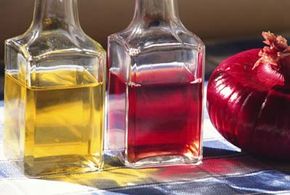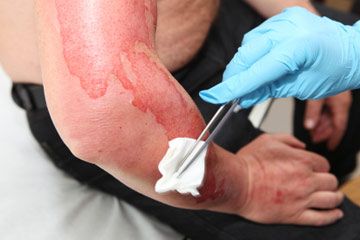If you find yourself the victim of a minor burn, these home remedies are likely to help minimize the pain. More serious burns should receive medical attention.
From the Home Remedies Cupboard
Honey. If you're suffering from a burn, the treatment should at least be sweet. Honey has long been a folk remedy to disinfect wounds and heal burns. Everyone knows bees are attracted to honey, but did you know water is, too? When applied to a burn, honey draws out fluids from the tissues, effectively cleaning the wound. You may also apply the honey to a gauze bandage, which is less sticky than direct application. On a piece of sterile gauze, place a dollop of honey and put the bandage directly on the burn, honey-side down. Change the dressing three to four times a day.
Oatmeal. As minor burns heal, they can become itchy. A good way to relieve the itch is by putting this breakfast cereal into the tub. Crumble 1 cup uncooked oatmeal into a bath of lukewarm water as the tub is filling. Soak 15 to 20 minutes and then air dry so that a thin coating of oatmeal remains on your skin. Use caution getting in and out of the tub since the oatmeal makes surfaces slippery.
Salt. Mouth burns can be relieved by rinsing with salt water every hour or so. Mix 1/2 teaspoon salt in 8 ounces warm water.
Tea bags. Teatime can be anytime you suffer a minor burn. The tannic acid found in black tea helps draw heat from a burn. Put 2 to 3 tea bags under a spout of cool water and collect the tea in a small bowl. Gently dab the liquid on the burn site.
Another method is to make a concoction using 3 or 4 tea bags, 2 cups fresh mint leaves, and 4 cups boiling water. Strain liquid into a jar and allow to cool. To use, dab the mixture on burned skin with a cotton ball or washcloth.
If you're on the go, you can also make a stay-in-place poultice out of 2 or 3 wet tea bags. Simply place cool, wet tea bags directly on the burn and wrap them with a piece of gauze to hold them in place.
Vinegar. Vinegar works as an astringent and antiseptic on minor burns and helps prevent infection. Dilute the vinegar with equal parts water, and rinse the burned area with the solution.
From the Home Remedies Freezer
Ice cube. A tongue burn is best treated with ice rather than cool water. Often, in great anticipation, children (and adults, for that matter) sip their soup or hot chocolate before it cools down and get a tongue burn. Since it's tricky to stick a burned tongue under the faucet, try sucking on an ice cube. First rinse the cube under water so it doesn't stick to the tongue or lips.
From the Home Remedies Refrigerator
Milk. Got milk? Then you've also got a great way to soothe a burn. For a minor burn, soak the burned area in milk for 15 minutes or so. You may also apply a cloth soaked in milk to the area. Repeat every few hours to relieve pain. Be sure to wash out the cloth after use, as it will sour quickly.
Plantain leaves. In the folk medicine of the Seneca Indians, as well as the contemporary writing of New Englanders and the Hispanics of the American Southwest, plantain is a popular remedy for treating burns. These green weedy plants (plantago major) are native to Europe and Asia but now grow practically anywhere in the world with sufficient water. Just don't confuse this plantain with the banana-like vegetable of the same name.
The leaves of plantain are primarily used as medicine. The major constituents in plantain are mucilage, iridoid glycosides (particularly aucubin), and tannins. Together these constituents are thought to give plantain mild anti-inflammatory, antimicrobial, antihemorrhagic, and expectorant actions. To get the full effect of this plant, crush some fresh plantain leaves and rub the juice directly onto the burn.
From the Home Remedies Sink
Cool water. While ice is nice for sore muscles, cool water is the best liquid refreshment for burned skin. Ice can restrict blood flow to the burn site and further damage delicate tissues. Instead, gently run cool water or place cool compresses over the burn site for ten minutes. Do this as quickly as possible, preferably within seconds of getting a burn. Cool water not only feels good but will help stop the burn from spreading, and the sooner you run cool water on the burn, the greater the effect will be to reduce it.
Do's and Don'ts
- Out of all areas in the home, the kitchen is number one for getting burns. The reasons are obvious, as are many of the precautions you can take to prevent an accident.
- DO lower the temperature of your hot-water heater to below 120 degrees F. A second-degree burn can happen within seconds in water that's hotter than 120 degrees.
- DO turn pot handles toward the back of the stove.
- Do keep that steaming cup of java out of a child's reach, which means off the coffee table or other low-lying areas.
- DO cover all electrical outlets with specially made caps if children are present.
- DON'T ever leave a child unattended in the kitchen.
- DO make the stove area off-limits to children.
- DO put a childproof lock on the oven door.
- DO keep oven mitts and potholders handy when cooking.
- DO keep a fire extinguisher and a box of baking soda nearby, in case of a grease fire.
For more information about burns and how to treat them them, try the following links:
- To see all of our home remedies and the conditions they treat, go to our main Home Remedies page.
- While serious burns need to be seen by a doctor, you can treat minor burns at home using plants that you may have in your garden. Learn how in Herbal Remedies for Burns.
- Learn all about a significant cause of burns -- fire -- in How Fire Works.
- Put out that fire with an efffective fire extinguisher. Understand this essential appliance in How Fire Extinguishers Work.
David J. Hufford, Ph.D., is university professor and chair of the Medical Humanities Department at Pennsylvania State University's College of Medicine. He also is a professor in the departments of Neural and Behavioral Sciences and Family and Community Medicine. Dr. Hufford serves on the editorial boards of several journals, including Alternative Therapies in Health & Medicine and Explore.
This information is solely for informational purposes. IT IS NOT INTENDED TO PROVIDE MEDICAL ADVICE. Neither the Editors of Consumer Guide (R), Publications International, Ltd., the author nor publisher take responsibility for any possible consequences from any treatment, procedure, exercise, dietary modification, action or application of medication which results from reading or following the information contained in this information. The publication of this information does not constitute the practice of medicine, and this information does not replace the advice of your physician or other health care provider. Before undertaking any course of treatment, the reader must seek the advice of their physician or other health care provider.


